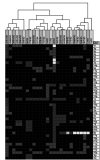Assessment of clonal relationships in ipsilateral and bilateral multiple breast carcinomas by comparative genomic hybridisation and hierarchical clustering analysis
- PMID: 15266323
- PMCID: PMC2364777
- DOI: 10.1038/sj.bjc.6602021
Assessment of clonal relationships in ipsilateral and bilateral multiple breast carcinomas by comparative genomic hybridisation and hierarchical clustering analysis
Abstract
The issue of whether multiple, ipsilateral or bilateral, breast carcinomas represent multiple primary tumours or dissemination of a single carcinomatous process has been difficult to resolve, especially for individual patients. We have addressed the problem by comparative genomic hybridisation analysis of 26 tumours from 12 breast cancer patients with multiple ipsilateral and/or bilateral carcinoma lesions. Genomic imbalances were detected in 25 of the 26 (96%) tumours. Using the genomic imbalances detected in these 26 lesions as well as those previously found by us in an independent series of 35 unifocal breast carcinomas, we compared a probabilistic model for likelihood of independence with unsupervised hierarchical clustering methodologies to determine the clonal relatedness of multiple tumours in breast cancer patients. We conclude that CGH analysis of multiple breast carcinomas followed by unsupervised hierarchical clustering of the genomic imbalances is more reliable than previous criteria to determine the tumours' clonal relationship in individual patients, that most ipsilateral breast carcinomas arise through intramammary spreading of a single breast cancer, and that most patients with bilateral breast carcinomas have two different diseases.
Figures



References
-
- Ackerman J, Baunoch DA, Gimotty P, George J, Lane MA, Dawson PJ (1995) The role of p53 mutations in bilateral breast carcinoma. Mod Pathol 8: 244–248 - PubMed
-
- Anastassiades O, Iakovou E, Stavridou N, Gogas J, Karameris A (1993) Multicentricity in breast cancer. A study of 366 cases. Am J Clin Pathol 99: 238–243 - PubMed
-
- Connolly JL, Harris JR, Schnitt SJ (1995) Understanding the distribution of cancer within the breast is important for optimizing breast-conserving treatment. Cancer 76: 1–3 - PubMed
-
- Dawson PJ (1993) What is new in our understanding of multifocal breast cancer. Pathol Res Pract 189: 111–116 - PubMed
-
- Dawson PJ, Baekey PA, Clark RA (1995) Mechanisms of multifocal breast cancer: an immunocytochemical study. Hum Pathol 26: 965–969 - PubMed
Publication types
MeSH terms
LinkOut - more resources
Full Text Sources
Medical

